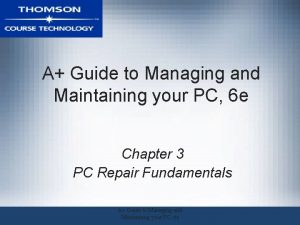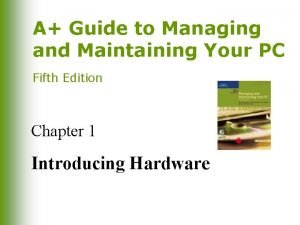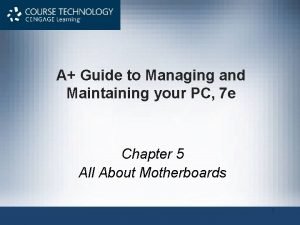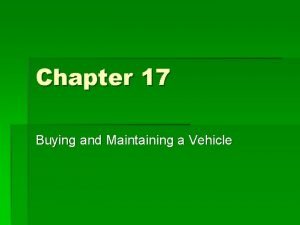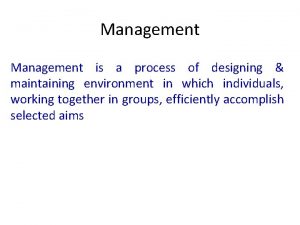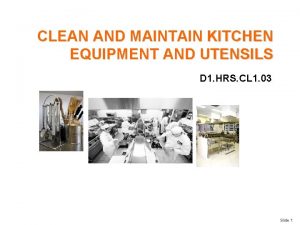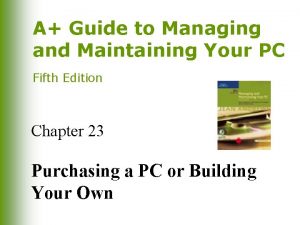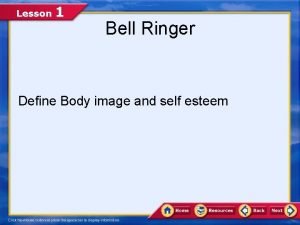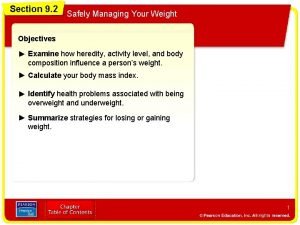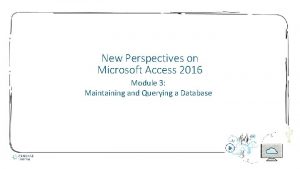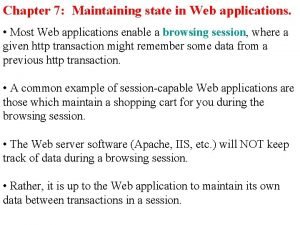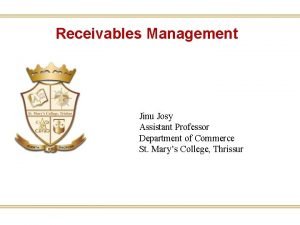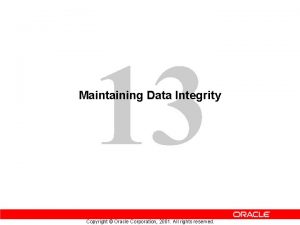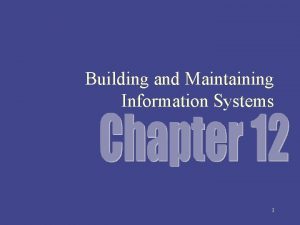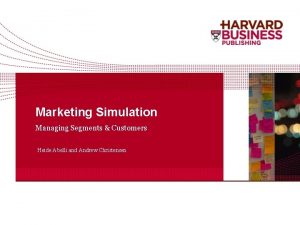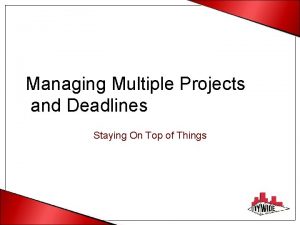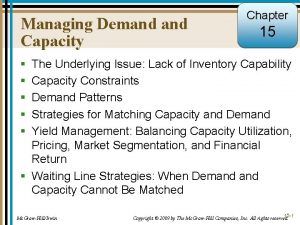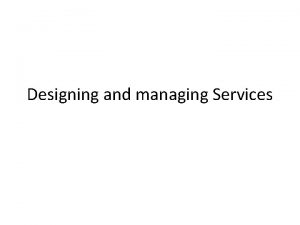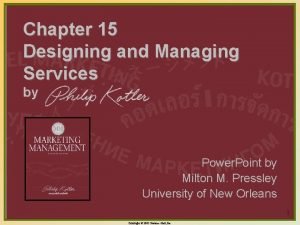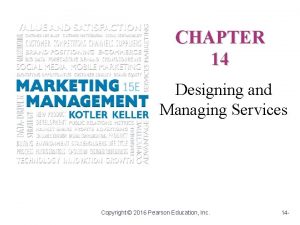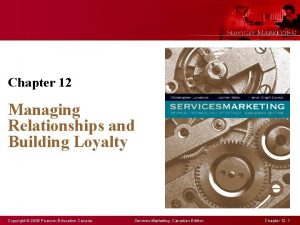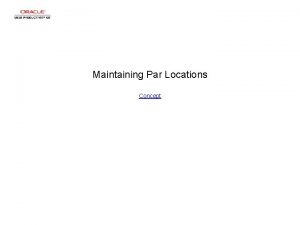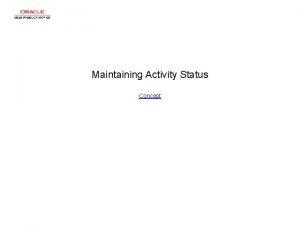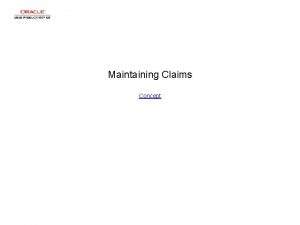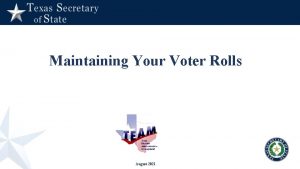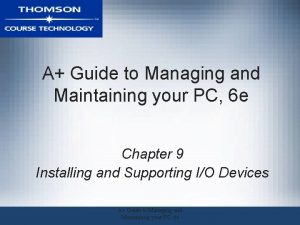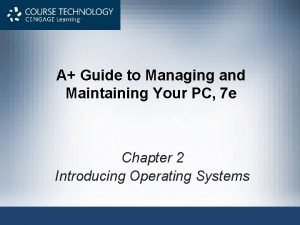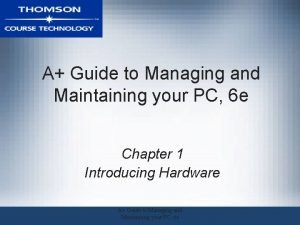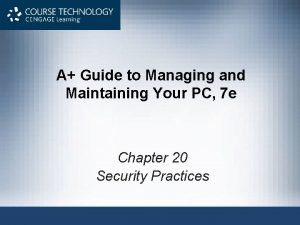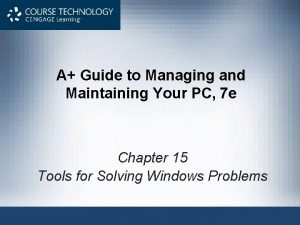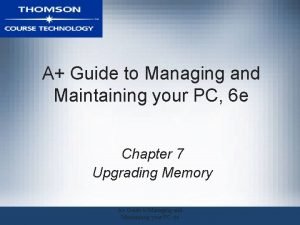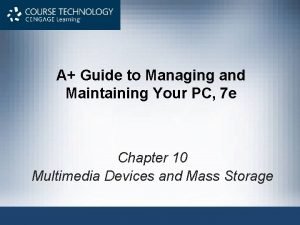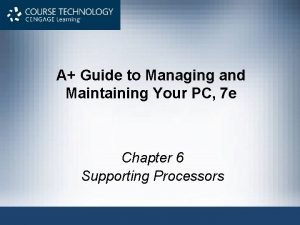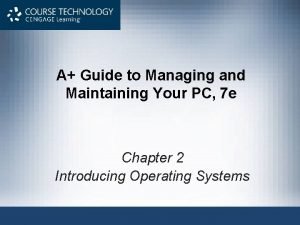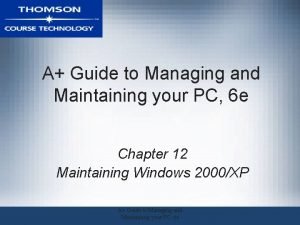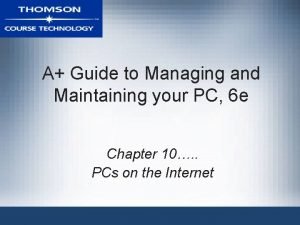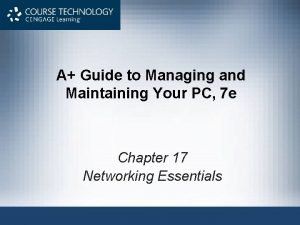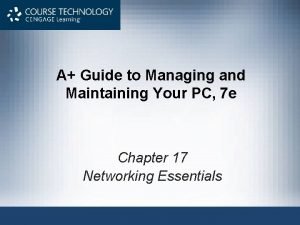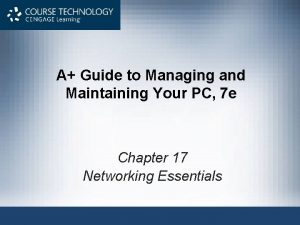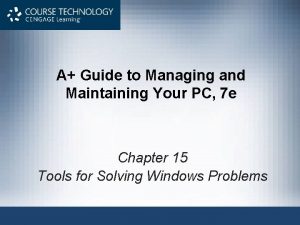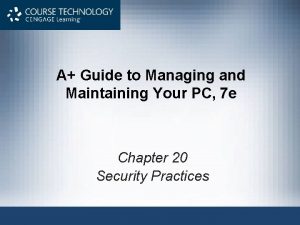A Guide to Managing and Maintaining Your PC























































![Commands To Manage Files and Folders (cont’d. ) • Xcopy <source> [<destination>] [/S] [/C] Commands To Manage Files and Folders (cont’d. ) • Xcopy <source> [<destination>] [/S] [/C]](https://slidetodoc.com/presentation_image_h/3807b7a5288d43a1154d3aaff2cc58d7/image-56.jpg)
![Commands To Manage Files and Folders (cont’d. ) • Robocopy <source> [<destination>] [/S] [/E] Commands To Manage Files and Folders (cont’d. ) • Robocopy <source> [<destination>] [/S] [/E]](https://slidetodoc.com/presentation_image_h/3807b7a5288d43a1154d3aaff2cc58d7/image-57.jpg)
![Commands To Manage Files and Folders (cont’d. ) • MD [drive: ]path – Creates Commands To Manage Files and Folders (cont’d. ) • MD [drive: ]path – Creates](https://slidetodoc.com/presentation_image_h/3807b7a5288d43a1154d3aaff2cc58d7/image-58.jpg)
![Commands To Manage Files and Folders (cont’d. ) • chkdsk [drive: ] [/f] [/r] Commands To Manage Files and Folders (cont’d. ) • chkdsk [drive: ] [/f] [/r]](https://slidetodoc.com/presentation_image_h/3807b7a5288d43a1154d3aaff2cc58d7/image-59.jpg)
![Commands To Manage Files and Folders (cont’d. ) • Defrag [drive: ] [-C] – Commands To Manage Files and Folders (cont’d. ) • Defrag [drive: ] [-C] –](https://slidetodoc.com/presentation_image_h/3807b7a5288d43a1154d3aaff2cc58d7/image-60.jpg)
![Commands To Manage Files and Folders (cont’d. ) • Format <drive: > [/v: label] Commands To Manage Files and Folders (cont’d. ) • Format <drive: > [/v: label]](https://slidetodoc.com/presentation_image_h/3807b7a5288d43a1154d3aaff2cc58d7/image-61.jpg)









- Slides: 70

A+ Guide to Managing and Maintaining Your PC, 7 e Chapter 13 Maintaining Windows

Objectives • Learn how to set up and perform scheduled preventive maintenance tasks to keep Windows healthy • Learn how to prepare for disaster by keeping good backups of use data and Windows system files • Learn about the directory structures used by Windows and how to manage files and folders • Learn how to use Windows utilities to manage hard drives A+ Guide to Managing and Maintaining Your PC, 7 e 2

Scheduled Preventive Maintenance • Preventive maintenance – Alleviates slow computer performance • Tasks – – – Verifying Windows settings Defragmenting the hard drive Checking drive for errors Reducing startup processes to essentials Doing whatever it takes to free up hard drive space A+ Guide to Managing and Maintaining Your PC, 7 e 3

Verify Critical Windows Settings • Help user by explaining: – Automatic Windows updates importance – How to manually check for and install updates • Verify updates and service packs installed – Verify Windows Updates is configured correctly • Reasons automatic updates sometimes not set – Slow Internet connection – Lack of trust • Verify updates before installation • Know if update applies to the system A+ Guide to Managing and Maintaining Your PC, 7 e 4

Verify Critical Windows Settings (cont’d. ) • Vista verification steps – 1. Verify all service packs installed – 2. View updates waiting to be installed – 3. Select updates to install – 4. Verify Windows installs updates A+ Guide to Managing and Maintaining Your PC, 7 e Figure 13 -2 Important Windows updates are not installed. Courtesy: Course Technology/Cengage Learning 5

Verify Critical Windows Settings (cont’d. ) • Windows XP verification steps – 1. View service packs installed – 2. View and manually install updates – 3. View how Windows XP installs updates • Windows 2000 verification steps – 1. Install updates • Click Start and Click Windows Updates • Verify antivirus software A+ Guide to Managing and Maintaining Your PC, 7 e 6

Clean Up the Hard Drive • Delete unneeded files occasionally – Windows requires some hard drive free space • Normal operation, defragmenting drives, burning CDs and DVDs, and other tasks • Determining hard drive free space – Open Windows Explorer – Right-click the drive and select Properties • Using Disk Cleanup utility (Vista and XP) – Deletes temporary files • Run cleanmgr. exe in Start Search box • Use Windows Explorer, Properties box, General tab A+ Guide to Managing and Maintaining Your PC, 7 e 7

Clean Up the Hard Drive (cont’d. ) • Windows. old folder – Delete if user no longer needs the data • Freeing up more Windows Vista disk space – Uninstall software • Click More Options tab on the Disk Cleanup box • Click Clean up in Programs and Features area – Delete all but the most recent restore points A+ Guide to Managing and Maintaining Your PC, 7 e 8

Defrag the Hard Drive • Fragmentation – Files fragmented in segments all over the drive • Reasons to defragment – Read-write head moves all over to retrieve a file – Data-recovery utilities may not work • Defragment when user not using the PC • Vista default – Automatic defrag every Wednesday at 1: 00 AM • Defrag a healthy drive with 15% free space A+ Guide to Managing and Maintaining Your PC, 7 e 9

Defrag the Hard Drive (cont’d. ) • Verify Vista default defrag setting or manually defrag Figure 13 -9 The Properties box for a drive allows you to manage the Disk Defragmenter Courtesy: Course Technology/Cengage Learning A+ Guide to Managing and Maintaining Your PC, 7 e 10

Defrag the Hard Drive (cont’d. ) • Verify XP default defrag setting or manually defrag Figure 13 -10 Windows XP defragmenting a volume Courtesy: Course Technology/Cengage Learning A+ Guide to Managing and Maintaining Your PC, 7 e 11

Check the Hard Drive for Errors • Chkdsk utility – Searches for bad sectors on a volume – Recovers data if possible • Error checking and repair time – Potentially long depending on drive size and files • Methods to launch Chkdsk utility in Vista or XP – Windows Explorer drive Properties box – Chkdsk command in a command prompt window A+ Guide to Managing and Maintaining Your PC, 7 e 12

Figure 13 -11 Windows repairs hard drive errors under the drive’s Properties box using Windows Explorer. Courtesy: Course Technology/Cengage Learning A+ Guide to Managing and Maintaining Your PC, 7 e 13

Verify Startup Programs • Software programs – Add themselves to automatic startup list • Shortcut or program file in a startup folder • Registry entry • Scheduled Task list entry • Problem with too may startup programs – Slow system startup, sluggish system, startup errors • Problem solution – Remove unnecessary programs A+ Guide to Managing and Maintaining Your PC, 7 e 14

Verify Startup Programs (cont’d. ) • Startup programs in Vista • Windows Vista startup folders – For individual users: • C: UsersusernameApp. DataRoamingMicrosoftWindo wsStart MenuProgramsStartup – For all users: • C: Program. DataMicrosoftWindowsStart MenuProgramStartup • Software Explorer – View and stop Vista startup programs A+ Guide to Managing and Maintaining Your PC, 7 e 15

Figure 13 -12 Use Software Explorer in Vista to find out what programs are launched at startup Courtesy: Course Technology/Cengage Learning A+ Guide to Managing and Maintaining Your PC, 7 e Figure 13 -13 A startup program is launched by using a startup folder Courtesy: Course Technology/Cengage Learning 16

Table 13 -1 Programs launched at startup on a barebones Vista system A+ Guide to Managing and Maintaining Your PC, 7 e 17

Verify Startup Programs (cont’d. ) • Startup programs in XP • Windows XP startup folders – For individual users: • C: Documents and SettingsusernameStart. MenuProgramsStartup – For all users: • C: Documents and SettingsAll UsersStart MenuProgramStartup • Manually look for unnecessary software – Uninstall with Control Panel, Add or Remove Programs applet A+ Guide to Managing and Maintaining Your PC, 7 e 18

Free Up Additional Hard Drive Space • Windows Explorer – Displays drive free space • No set minimum free space for Vista • Rule of thumb – Shoot for 15 percent of drive free • Move data to other drives or devices • Use NTFS drive or folder compressions A+ Guide to Managing and Maintaining Your PC, 7 e 19

Free Up Additional Hard Drive Space (cont’d. ) • Reorganize folders and volumes – Move applications • Most require reinstall • Move virtual memory paging file – Windows Pagefile. sys • Virtual memory enhancing amount of system RAM • Hidden file stored in C drive root directory – Move to another partition on the same or different drive • New drive speed should be equal to or greater than existing drive A+ Guide to Managing and Maintaining Your PC, 7 e 20

Figure 13 -15 Manage virtual memory using the System Properties box Courtesy: Course Technology/Cengage Learning A+ Guide to Managing and Maintaining Your PC, 7 e 21

Figure 13 -16 Move Pagefile. sys to a different drive Courtesy: Course Technology/Cengage Learning A+ Guide to Managing and Maintaining Your PC, 7 e 22

Free Up Additional Hard Drive Space (cont’d. ) • Limit space used by Internet Explorer (IE) – Reduce IE cache file space – Move cache folder to a second volume (if available) – Set IE to empty cache folder when browser closes • If more space is still needed, add another hard drive A+ Guide to Managing and Maintaining Your PC, 7 e 23

Figure 13 -17 Allocate hard drive space to be used for temporary Internet files Courtesy: Course Technology/Cengage Learning A+ Guide to Managing and Maintaining Your PC, 7 e Figure 13 -18 Set Internet Explorer not to keep a cache after the browser is closed Courtesy: Course Technology/Cengage Learning 24

Backup Procedures • Backup – Extra copy of a data or software file • Use if original file becomes damaged or destroyed • Ways to lose data – System failure, virus, file corruption, or some other problem • Never trust important data to only one media A+ Guide to Managing and Maintaining Your PC, 7 e 25

Planning For Disaster Recovery • Points for a backup and recovery plan – Decide on backup media – Consider purchasing third-party backup software • Easier to use • Offers more features than Microsoft utility – Use a selective backup plan • Only back up data that changes often to save time – Back up after every four to ten hours of data entry A+ Guide to Managing and Maintaining Your PC, 7 e 26

Planning For Disaster Recovery (cont’d. ) • Points for a backup and recovery plan (cont’d. ) – Record regular backups in a log • • Folders or drives backed up Date of the backup Type of backup Label identifying tape, disk, or other media – First time backup • Verify backup tape disks • Verify successful recovery of data – Keep backups in a safe place • Routinely test A+ Guide to Managing and Maintaining Your PC, 7 e 27

Back Up User Data • Windows Vista backup utility – 1. Connect backup device to PC – 2. Backup and Restore Center window – 3. Click Back up files and respond to the UAC box • Select where to save backup and click Next – 4. Select volumes containing folders or files to back up – 5. Select type of files to back up – 6. Select back up frequency A+ Guide to Managing and Maintaining Your PC, 7 e 28

Back Up User Data (cont’d. ) • Windows Vista file restore – 1. Open Backup Status and Configuration window – 2. Click Restore Files and follow directions • Windows Vista backup issues – Provides little control over the folders – Many turn to third-party backup utilities • Back up e-mail messages and address book • Back up Internet Explorer favorites list A+ Guide to Managing and Maintaining Your PC, 7 e 29

Back Up User Data (cont’d. ) • Windows 2000/XP Ntbackup. exe utility – 1. Open Backup Wizard and click Advanced Mode – 2. Within the Backup utility, click Backup tab • To perform immediate backup check the drive and subfolders – 3. Change backup destination location (if desired) – 4. Click Start Backup button in the lower-right corner A+ Guide to Managing and Maintaining Your PC, 7 e 30

Figure 13 -25 Backup or Restore Wizard Courtesy: Course Technology/Cengage Learning Figure 13 -26 You can perform an immediate backup from the Backup tab Courtesy: Course Technology/Cengage Learning A+ Guide to Managing and Maintaining Your PC, 7 e 31

Back Up User Data (cont’d. ) • Windows 2000/XP scheduled backup options – – – Full backup (also called a normal backup) Copy backup Incremental backup Differential backup Daily backup • Two best ways to schedule backups – Combination of full backups and incremental backups – Combination of full backups and differential backups A+ Guide to Managing and Maintaining Your PC, 7 e 32

Back Up User Data (cont’d. ) • Windows 2000/XP backup schedule – 1. Open backup utility, click Schedule Jobs tab, select date to schedule a backup, click Add Job button – 2. Backup Wizard opens, click Next • Select Back up selected files, drives, or network data, click Next – 3. Select drives, folders, files to back up, click Next A+ Guide to Managing and Maintaining Your PC, 7 e 33

Back Up User Data (cont’d. ) • Windows 2000/XP backup schedule (cont’d. ) – 4. Choose where to save the backup, a back up name and type – 5. Make decisions on verifying data, compressing the data, and appending the data – 6. Select perform back up later – 7. Use Schedule Job window to select how often backup occurs – 8. Click Next in the wizard and follow remaining instructions A+ Guide to Managing and Maintaining Your PC, 7 e 34

Back Up User Data (cont’d. ) • Windows 2000/XP additional items to back up: – E-mail messages and address book – Internet Explorer favorites list Figure 13 -28 Schedule repeated backups Courtesy: Course Technology/Cengage Learning A+ Guide to Managing and Maintaining Your PC, 7 e 35

Back Up System Files • System Restore – Restores system to a restore point • Restore point – Condition at time a snapshot taken • System Restore turned on – Windows automatically creates a restore point • Before new software or hardware installed or when changes are made to system • Can manually create restore point at any time A+ Guide to Managing and Maintaining Your PC, 7 e 36

Figure 13 -29 Manually create a restore point Courtesy: Course Technology/Cengage Learning A+ Guide to Managing and Maintaining Your PC, 7 e 37

Back Up System Files (cont’d. ) • Keep system protection turned on – Creates restore points • At regular intervals • Just before new software or hardware installed • Restore point information: – Normally kept in folder C: System Volume • Not accessible to the user – Taken at least every 24 hours – Can use up to 15 percent of disk space • When disk space is low, restore points are no longer made A+ Guide to Managing and Maintaining Your PC, 7 e 38

Figure 13 -30 Make sure System Protection is turned on Courtesy: Course Technology/Cengage Learning A+ Guide to Managing and Maintaining Your PC, 7 e 39

Back Up System Files (cont’d. ) • Applying a restore point – User data not altered – Can affect installed software, hardware, user settings, and OS configuration settings – Changes made to settings are lost after restore point is created – Always use most recent restore point capable of fixing the problem – If Vista will not boot: • Launch System Restore from Vista Recovery Environment A+ Guide to Managing and Maintaining Your PC, 7 e 40

Back Up System Files (cont’d. ) • Applying a restore point (cont’d. ) • Windows Vista or Windows XP desktop – 1. Open System Restore box – 2. If multiple restore points exist, two options display: • Use recommended restore point • Choose a different restore point – 3. System restarts and restore point is applied A+ Guide to Managing and Maintaining Your PC, 7 e 41

Back Up System Files (cont’d. ) • Points about system restore – Great tool for fixing a device, restoring Windows settings, and solving application problems – Limitations • • Recovers from errors only if registry somewhat intact Process cannot remove virus or worm infection Process might create a new problem Process might make many changes to a system Process requires restore points Restore points kept in a hidden folder on the hard drive Viruses and malware sometimes hide in restore points A+ Guide to Managing and Maintaining Your PC, 7 e 42

Back Up System Files (cont’d. ) • Backing up system state using Windows XP/2000 – All files are backed up – Use Backup, Advanced Mode Figure 13 -33 Back up the Windows XP/2000 system state Courtesy: Course Technology/Cengage Learning A+ Guide to Managing and Maintaining Your PC, 7 e 43

Back Up System Files (cont’d. ) • Restoring system state using Windows XP/2000 – Open Backup Utility window • Click the Restore and Manage Media tab Figure 13 -34 Restore the system state from the Restore and Manage Media tab of the Backup dialog box Courtesy: Course Technology/Cengage Learning A+ Guide to Managing and Maintaining Your PC, 7 e 44

Back Up the Entire Hard Drive • Windows Vista Complete PC Backup – Backup of entire Vista volume • Can back up other volumes – Best practice • Complete PC backup after Vista, all hardware devices, and all applications are installed – Works similarly to recovery CDs or DVDs – Save complete PC backup to a local device – Vista uses incremental backup to keep initial backup current A+ Guide to Managing and Maintaining Your PC, 7 e 45

Back Up the Entire Hard Drive (cont’d. ) • Windows XP Automated System Recovery (ASR) – Backup of entire XP volume – Recover XP system from last ASR backup – Lose everything on the volume since ASR backup created • Installed software and device drivers, user data, any changes to system configuration – ASR backup process creates two items • Full backup of the Windows drive • ASR floppy disk containing backup file location A+ Guide to Managing and Maintaining Your PC, 7 e 46

Back Up the Entire Hard Drive (cont’d. ) • Windows XP ASR (cont’d. ) – Restoring the system using an ASR backup • Restores Windows volume to its state when last ASR backup made – ASR recovery process • Erases everything on the volume being restored • Reformats the volume – After ASR recovery process finished • Restart the system • Restore user data from recent backups A+ Guide to Managing and Maintaining Your PC, 7 e 47

Managing Files, Folders, and Hard Drives • Understanding of how to manage folders and files – Manage data, configure Windows, set up network resources, and keep the PC in good working order • Knowing where to look on the hard drive to find folders and files needed – Requires understanding of directory structures used by Windows Vista, XP, and 2000 A+ Guide to Managing and Maintaining Your PC, 7 e 48

Directory Structures • Know user files, system files, fonts, temporary files, program files, and offline files and folders • User profile contents – User folder together with subfolders is the user profile namespace – Ntuser. dat in the user’s folder containing user settings • Windows Vista user account folder – Stored in C: Users • Windows XP user account folder – Stored in C: Documents and Settings folder A+ Guide to Managing and Maintaining Your PC, 7 e 49

Directory Structures (cont’d. ) • Other important folder locations – Windows registry: Windowssystem 32config folder – Registry backup: Windowssystem 32configReg. Back folder – Fonts: stored in the WindowsFonts folder – Program files (32 -bit versions) • C: Program Files – Program Files (Vista and XP 64 -bit versions) • C: Program Files (64 -bit programs) • C: Program Files (x 86) (32 -bit programs) A+ Guide to Managing and Maintaining Your PC, 7 e 50

Directory Structures (cont’d. ) • Other important folder locations (cont’d. ) – Temporary files: WindowsTemp folder – Windows Vista temporary IE files: • C: UsersusernameApp. DataLocalMicrosoftWindows Temporary Internet Files – Windows XP temporary IE files: • C: Documents and SettingsusernameLocal SettingsTemporary Internet Files – Client-side caching (CSC) folder: C: WindowsCSC A+ Guide to Managing and Maintaining Your PC, 7 e 51

Commands To Manage Files and Folders • Command prompt window – Open by entering cmd. exe • Vista Start Search box or XP Run box – Provides a Command Line Interface (CLI) • Enter command lines to perform a variety of tasks Figure 13 -43 Use the exit command to close the command prompt window Courtesy: Course Technology/Cengage Learning A+ Guide to Managing and Maintaining Your PC, 7 e 52

Commands To Manage Files and Folders (cont’d. ) • File naming conventions – Filename and file extension characters • Letters a through z and numbers 0 through 9 • Characters: _ ^ $ ! # % & – { } ( ) @ ' ` – Filename with spaces: • Enclose filename in double quotation marks • Wildcard characters in command lines – Question mark (? ): wildcard for one character – Asterisk (*): wildcard for one or more characters A+ Guide to Managing and Maintaining Your PC, 7 e 53

Commands To Manage Files and Folders (cont’d. ) • Help or <command name> /? • Dir [<filename>] [/p] [/s] [/w] – List files and directories Table 13 -3 Sample dir commands A+ Guide to Managing and Maintaining Your PC, 7 e 54

Commands To Manage Files and Folders (cont’d. ) • Del or Erase <filename> – Erases files or groups of files • Copy <source> [<destination>] [/A] [/V] [/Y] – Three useful switches or parameters • /A: only copies only files with the archive attribute on • /V: size of each new file compared to the size of original file • /Y: confirmation message does not appear asking to confirm before overwriting a file • Recover <filename> – Attempts to recover a file when parts corrupted A+ Guide to Managing and Maintaining Your PC, 7 e 55
![Commands To Manage Files and Folders contd Xcopy source destination S C Commands To Manage Files and Folders (cont’d. ) • Xcopy <source> [<destination>] [/S] [/C]](https://slidetodoc.com/presentation_image_h/3807b7a5288d43a1154d3aaff2cc58d7/image-56.jpg)
Commands To Manage Files and Folders (cont’d. ) • Xcopy <source> [<destination>] [/S] [/C] [/Y] [/D: date] – More powerful than Copy command Table 13 -4 Xcopy commands and results A+ Guide to Managing and Maintaining Your PC, 7 e 56
![Commands To Manage Files and Folders contd Robocopy source destination S E Commands To Manage Files and Folders (cont’d. ) • Robocopy <source> [<destination>] [/S] [/E]](https://slidetodoc.com/presentation_image_h/3807b7a5288d43a1154d3aaff2cc58d7/image-57.jpg)
Commands To Manage Files and Folders (cont’d. ) • Robocopy <source> [<destination>] [/S] [/E] [/LOG: filename] [/LOG+: filename] [/move] [/purge] – Robust File Copy command • New with Windows Vista; similar to Xcopy command Table 13 -5 Robocopy commands and results A+ Guide to Managing and Maintaining Your PC, 7 e 57
![Commands To Manage Files and Folders contd MD drive path Creates Commands To Manage Files and Folders (cont’d. ) • MD [drive: ]path – Creates](https://slidetodoc.com/presentation_image_h/3807b7a5288d43a1154d3aaff2cc58d7/image-58.jpg)
Commands To Manage Files and Folders (cont’d. ) • MD [drive: ]path – Creates a subdirectory under a directory • CD [drive: ]path or CD. . – Changes current default directory • RD [drive: ]path – Removes a subdirectory • Directory must contain no files • Directory must contain no subdirectories • Directory must not be current directory A+ Guide to Managing and Maintaining Your PC, 7 e 58
![Commands To Manage Files and Folders contd chkdsk drive f r Commands To Manage Files and Folders (cont’d. ) • chkdsk [drive: ] [/f] [/r]](https://slidetodoc.com/presentation_image_h/3807b7a5288d43a1154d3aaff2cc58d7/image-59.jpg)
Commands To Manage Files and Folders (cont’d. ) • chkdsk [drive: ] [/f] [/r] – Fixes file system errors – Recovers data from bad sectors Figure 13 -45 Lost and cross-linked clusters Courtesy: Course Technology/Cengage Learning A+ Guide to Managing and Maintaining Your PC, 7 e 59
![Commands To Manage Files and Folders contd Defrag drive C Commands To Manage Files and Folders (cont’d. ) • Defrag [drive: ] [-C] –](https://slidetodoc.com/presentation_image_h/3807b7a5288d43a1154d3aaff2cc58d7/image-60.jpg)
Commands To Manage Files and Folders (cont’d. ) • Defrag [drive: ] [-C] – Examines a drive for fragmented files • Rewrites fragmented files in contiguous clusters • Edit [drive: path] <filename> – Edit program (Edit. com) Table 13 -6 Defrag commands and results A+ Guide to Managing and Maintaining Your PC, 7 e 60
![Commands To Manage Files and Folders contd Format drive v label Commands To Manage Files and Folders (cont’d. ) • Format <drive: > [/v: label]](https://slidetodoc.com/presentation_image_h/3807b7a5288d43a1154d3aaff2cc58d7/image-61.jpg)
Commands To Manage Files and Folders (cont’d. ) • Format <drive: > [/v: label] [/q] [fs: <filesystem>] – Format command Table 13 -7 Format commands and results A+ Guide to Managing and Maintaining Your PC, 7 e 61

Use Disk Management To Manage Hard Drives • Primary tool for managing hard drives – Manage partitions, mount a drive, or troubleshoot problems with the hard drive • A partition is division of a hard drive • Volumes are primary partitions – Active partition used by BIOS for OS load – Extended partition holds one or more logical drives • File system manages files and folders – Custer: group of sectors used to hold a file – NTFS, FAT 32, and ex. FAT A+ Guide to Managing and Maintaining Your PC, 7 e 62

Use Disk Management To Manage Hard Drives (cont’d. ) • New hard drive – Initialize the disk – Create new volumes – Resize volumes Figure 13 -48 Use Disk Management to partition a new hard drive. Courtesy: Course Technology/Cengage Learning A+ Guide to Managing and Maintaining Your PC, 7 e 63

Use Disk Management To Manage Hard Drives (cont’d. ) • Mounted drive – Volume accessible by a folder on another volume • Folder has more available space – Mount point: C: Data folder Figure 13 -51 The C: Data folder is the mount point for the mounted drive. Courtesy: Course Technology/Cengage Learning A+ Guide to Managing and Maintaining Your PC, 7 e 64

Use Disk Management To Manage Hard Drives (cont’d. ) • Use of mounted drives – Need to expand drive space • Drive C too small • Want to enhance space using space on another volume – Want to put all user data on another volume or hard drive, other than the Windows volume – Ran out of drive letters A through Z A+ Guide to Managing and Maintaining Your PC, 7 e 65

Use Disk Management To Manage Hard Drives (cont’d. ) • Windows dynamic disks – Better reliability, spanning, stripping (RAID 0) to improve performance, mirror two hard drives for fault tolerance (RAID 1) for XP Figure 13 -58 Basic disks use partitions to organize a hard drive, and dynamic disks use dynamic volumes to organize multiple hard drives Courtesy: Course Technology/Cengage Learning A+ Guide to Managing and Maintaining Your PC, 7 e 66

Use Disk Management To Manage Hard Drives (cont’d. ) • Windows dynamic disks (cont’d. ) – Disk Management converts two or more basic disks to dynamic disks • Create spanned or stripped volume • Spanning and software RAID is not very safe Figure 13 -60 Create a spanned or striped volume. Courtesy: Course Technology/Cengage Learning A+ Guide to Managing and Maintaining Your PC, 7 e 67

Use Disk Management To Manage Hard Drives (cont’d. ) • Drive and volume statuses: – – – – Healthy Failed Online Active Unallocated Formatting Basic Dynamic • Offline, foreign drive, and healthy (at risk) A+ Guide to Managing and Maintaining Your PC, 7 e 68

Regional and Language Settings • Configure computer to use a different language – – Download and install the language pack Change Windows display language Chang how numbers are formatted Change language used for keyboard input • Windows Vista Ultimate – Download Language Interface Packs (LIP) through Windows Update • Getting LIP for other Vista editions – Go to Microsoft Web site A+ Guide to Managing and Maintaining Your PC, 7 e 69

Summary • Regular preventive maintenance – Improves performance and troubleshooting • Verify Windows settings, defragment hard drives, check drive for errors, reduce startup process to essentials, and free up hard drive space • Windows offers may preventative maintenance tools • Preventative maintenance strategies – Maintain healthy Windows system and hardware resources – Keep good backups of data and system files A+ Guide to Managing and Maintaining Your PC, 7 e 70
 Guide to managing and maintaining your pc
Guide to managing and maintaining your pc Guide to managing and maintaining your pc
Guide to managing and maintaining your pc Guide to managing and maintaining your pc
Guide to managing and maintaining your pc Serve as your guide in managing your enterprise
Serve as your guide in managing your enterprise How to maintain deliverance
How to maintain deliverance Chapter 17 buying and maintaining a vehicle
Chapter 17 buying and maintaining a vehicle Preparation and maintenance of records and reports
Preparation and maintenance of records and reports The process of designing and maintaining an environment
The process of designing and maintaining an environment Building and maintaining a website
Building and maintaining a website Part of kitchen premises
Part of kitchen premises Elements of retail image
Elements of retail image Identify components of a retail image.
Identify components of a retail image. Maintaining a healthy body composition and body image
Maintaining a healthy body composition and body image Creating vision and strategic direction
Creating vision and strategic direction Purchasing and maintaining a computer
Purchasing and maintaining a computer The process of designing and maintaining an environment
The process of designing and maintaining an environment Maintaining a healthy body composition and body image
Maintaining a healthy body composition and body image Building and maintaining customer relationships
Building and maintaining customer relationships The way you see your body
The way you see your body Maintaining a healthy body composition and body image
Maintaining a healthy body composition and body image Give us your hungry your tired your poor
Give us your hungry your tired your poor Managing your personal finances textbook answers
Managing your personal finances textbook answers Chapter 16 managing the stress in your life
Chapter 16 managing the stress in your life Managing your online identity
Managing your online identity Managing your payables
Managing your payables Managing your weight part 2
Managing your weight part 2 Maintaining a professional image
Maintaining a professional image Class maintaining suffixes
Class maintaining suffixes Chapter 15:4 observing standard precautions
Chapter 15:4 observing standard precautions An extreme harmful eating behavior
An extreme harmful eating behavior Potential tension between maintaining confidentiality
Potential tension between maintaining confidentiality Maintaining a teachable spirit
Maintaining a teachable spirit Maintaining a website
Maintaining a website Access module 3 maintaining a database
Access module 3 maintaining a database Kohlberg's stages of moral development
Kohlberg's stages of moral development Maintaining effective partnerships
Maintaining effective partnerships Maintaining state in web applications
Maintaining state in web applications Maintaining transmission based isolation precautions
Maintaining transmission based isolation precautions Ways to maintain ecological balance
Ways to maintain ecological balance What is the meaning of receivable
What is the meaning of receivable The maintaining of an internal balance
The maintaining of an internal balance Maintaining student privacy
Maintaining student privacy Data integrity in oracle
Data integrity in oracle Maintaining curiosity
Maintaining curiosity Maintaining information systems
Maintaining information systems Compare and contrast the real self and ideal self
Compare and contrast the real self and ideal self Your conscious awareness of your own name and self identity
Your conscious awareness of your own name and self identity Your dreams stay big and your worries stay small
Your dreams stay big and your worries stay small Managing clinical risk
Managing clinical risk Marketing simulation managing segments and customers
Marketing simulation managing segments and customers Chapter 8 managing stress and anxiety
Chapter 8 managing stress and anxiety Managing multiple projects objectives and deadlines
Managing multiple projects objectives and deadlines Managing individual differences and behavior
Managing individual differences and behavior Managing individual differences and behavior
Managing individual differences and behavior Managing human resources in small and entrepreneurial firms
Managing human resources in small and entrepreneurial firms Demand vs capacity graph
Demand vs capacity graph Managing and using information systems
Managing and using information systems Chapter 4 managing stress and coping with loss notes
Chapter 4 managing stress and coping with loss notes Managing it services
Managing it services Designing and managing products
Designing and managing products Chapter 6 managing weight and body composition
Chapter 6 managing weight and body composition Managing ethics and social responsibility
Managing ethics and social responsibility Management of cash and marketable securities
Management of cash and marketable securities Diversity and regulatory challenges
Diversity and regulatory challenges Organization change and stress management
Organization change and stress management Managing human resources in small and entrepreneurial firms
Managing human resources in small and entrepreneurial firms Designing and managing services
Designing and managing services Services are typically produced and consumed simultaneously
Services are typically produced and consumed simultaneously Wheel of loyalty
Wheel of loyalty Extreme harmful eating behaviors
Extreme harmful eating behaviors Designing and managing integrated marketing communication
Designing and managing integrated marketing communication
